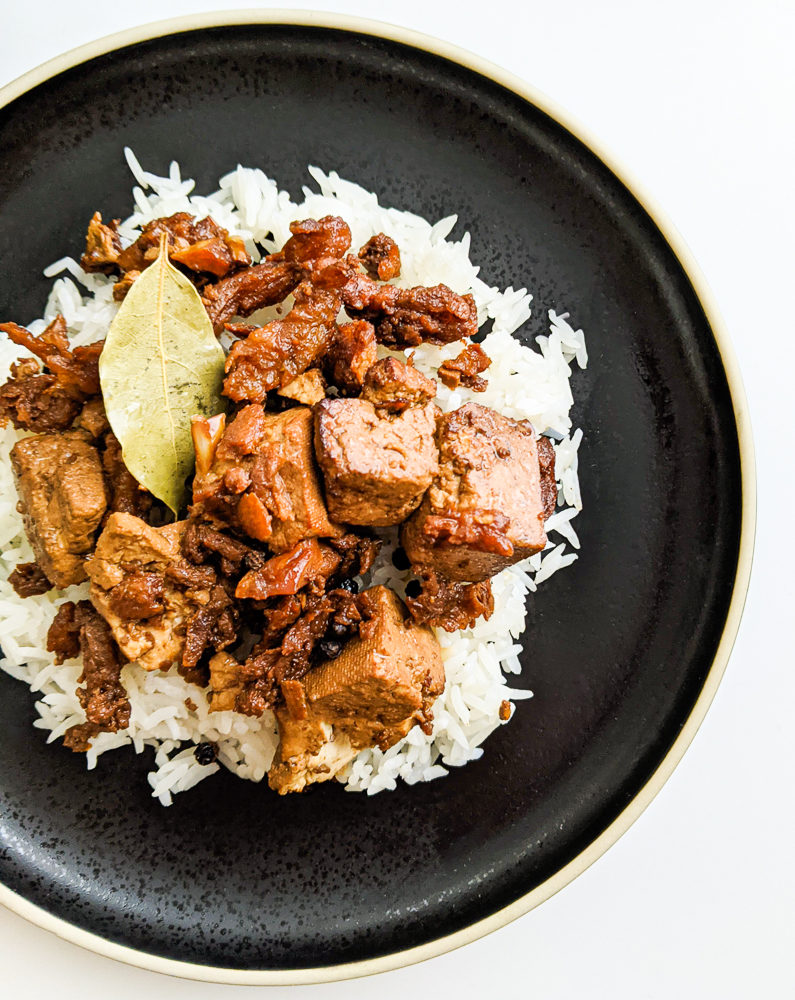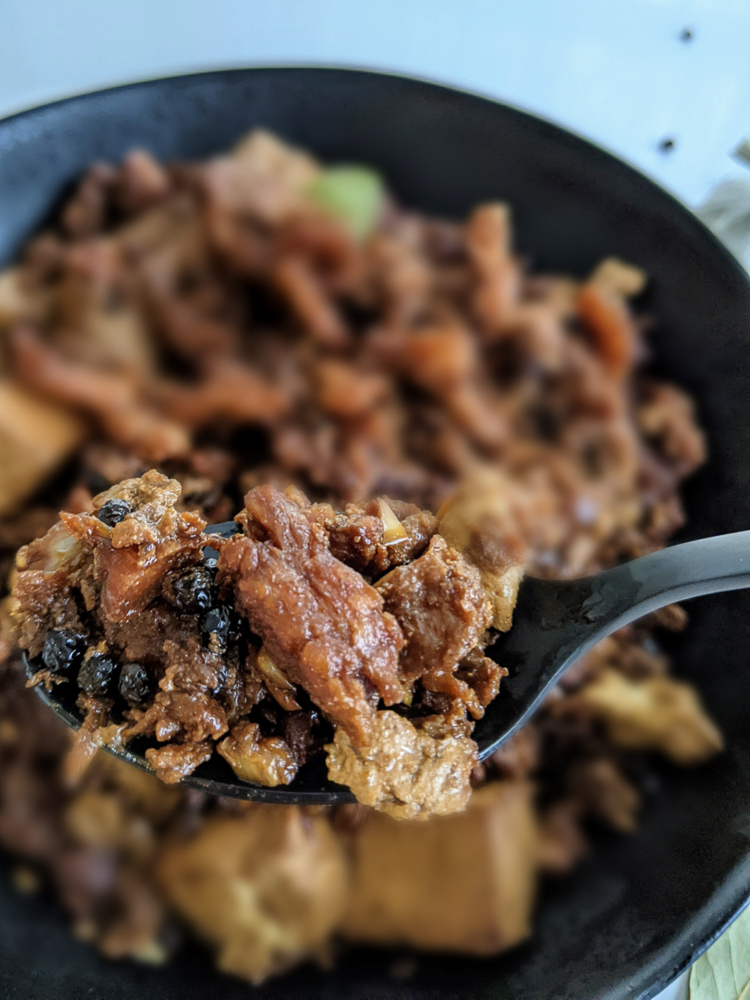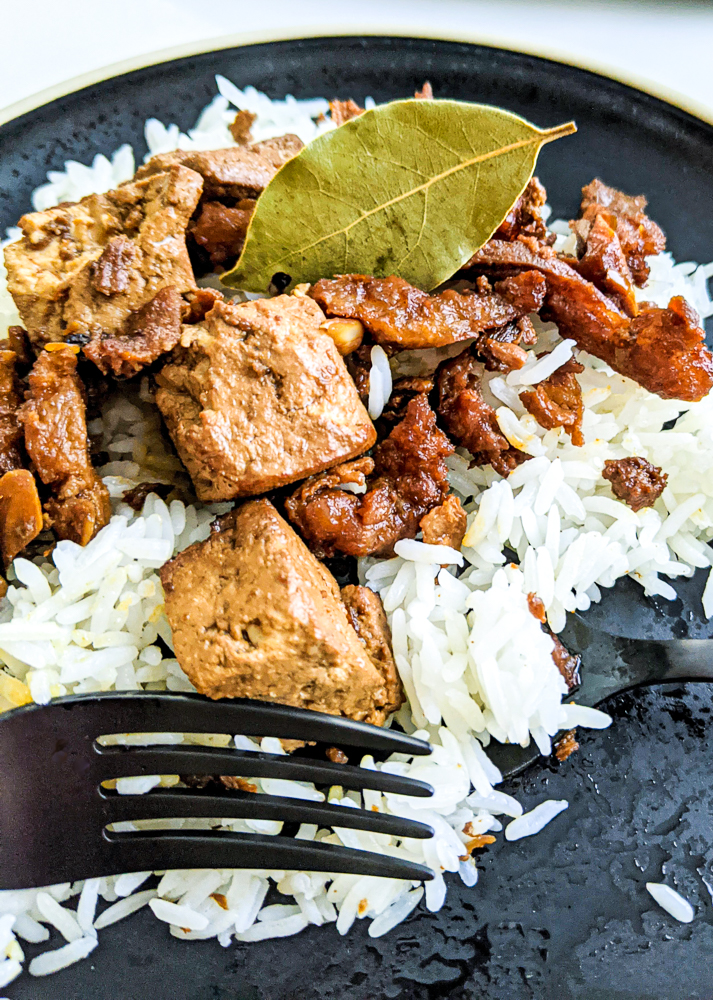Affiliate Disclosure: As an Amazon Associate, I earn from qualifying purchases. Thank you for supporting Bakeroise.

Hi! Today I bring you a 30-Minute Vegan Filipino Adobo Recipe. Along with vegan Filipino spaghetti, vegan Filipino adobo is my favorite Filipino food.

I am an Oakland-born-and-raised, first-generation Filipina-American who grew up in a traditional Filipino household where we regularly ate traditional Filipino food.
Filipino Adobo refers to two things: an indigenous method of cooking and the unofficial dish of the Philippines. Please don’t confuse the Filipino cooking method with the Spanish one just because they share the same name. The name was actually imposed on the Filipino cooking method by the Evil Colonizers from the Spanish Empire.
Filipino adobo, as the dish, is traditionally meat-based and stewed in vinegar, salt, garlic, peppercorns and dried bay leaves. Every family has their own unique recipe which can include ingredients such as ginger, potatoes, carrots and onions.
No matter what, this is a vinegary dish and it is meant to be.
Adobo, as the Philippine cooking method, came to be when the indigenous people would stew their dishes in vinegar and salt to preserve it due to their hot climate. This was centuries before refrigerators were even invented. When the barbaric colonizers arrived from the Spanish Empire in the 16th century, they didn’t have any contribution to the cooking method except for the imposed name. They can take credit for influencing a bunch of other dishes like Filipino afritada and Spanish bread or but they cannot take any credit for this one or even champorado (that credit goes to the Mexicans)!
So if you ever hear someone try to claim that the Spanish colonizers influenced that method of cooking, you can suggest they look up “adobo de los naturales” and they’ll learn the truth.

The Chinese traders in the Philippines, on the other hand, did have something to contribute to the dish (long after the dish existed): soy sauce. This was the beginning of adobong itim (black adobo due to soy sauce) which would go on to become known as the “traditional” version of the dish despite adobong puti (white adobo due to salt) being the original version of the dish.
Let’s talk about soy sauce for a little bit. There’s light soy sauce and what should’ve been dark soy sauce in this recipe. Dark soy sauce has sugar as an ingredient since it’s “the sweeter soy sauce” but because organic Chinese dark soy sauce is virtually nonexistent, I no longer use it.
Why not? Because conventional dark soy sauce that isn’t listed as vegan usually means that the sugar in the ingredients is conventional, which means that it’s been filtered through bone char. And that’s something that I do tend to get queasy about. That’s just where I draw my own line when it comes to what I’ll eat. Every vegan is different.
To get the sweeter taste that the dark soy sauce would normally contribute to the dish, I also add three tablespoons of organic light brown sugar. Dark brown sugar, while I love using it for baking my favorite cookies, would just make this dish too sweet.
Before I became vegan who wanted to turn this into a vegan Filipino adobo dish, I actually learned how to make adobong itim before adobong puti (white adobo) even though the latter is what I ate constantly throughout my childhood. Ironically, I did base this recipe on the adobong puti I had growing up. When I perfect my adobong puti recipe, I will share that as well.

This recipe for adobong itim starts off with a whole head of garlic, a good chunk of chopped ginger and whole black peppercorns cooking in vegetable oil which release the most pungent and warm aroma. The tofu and soy curls are then cooked in their marinade before being cooked in a rapid simmer in a medley of oil, vinegar and light soy sauce. At least two dried bay leaves are then added before the rapid simmering process to add a light, fresh taste to help balance out the heaviness of the dish. The dish cooks for 15 minutes uncovered until even the tofu is nice and brown. Then it’s finally done!
“But why do you use so much oil? OMG that’s not healthy!”

Well obviously! Which is why we’re not eating all of the oil. Let’s not be gross now!
Because we’re not using real meat, we’re not getting any rendered fats. So instead we are using natural vegetable oil which is way more ethical than rendering fat from what was once a living and breathing creature. The rendered animal fat was what cooked the aromatics well and helped the flavors cling to the proteins of traditional adobo. The vegetable oil we use in this recipe does almost the exact same thing except that it’s an oil that isn’t part of the protein itself.
When this rich and delicious adobong itim dish is done cooking, we will then drain it in a large, fine mesh strainer over a large bowl or food storage container and save the oil. In addition, we use a slotted spoon when serving to get rid of even more oil if possible.
But why do we save the bulk of the oil instead of discarding it? Well, it’s because the protein tends to dry out if it hasn’t been sitting in its marinade. So when reheating leftovers after straining excess oils, whether it’s on the stove or in the microwave, the protein that has been sitting in the marinade won’t dry out. This is true for even “real meat” so it’s not an issue only with soy. We’re not keeping the oil forever.

Soy is also a legume and a complete protein so both soy curls and tofu make a wonderful substitution for this dish.
Now that you have a very brief background on the history of Filipino adobo, I share with you my 30-Minute Vegan Filipino Reipe, adobong itim style. Remember to strain and drain that oil!
Print30-Minute Vegan Filipino Adobo
This is my 30-minute vegan Filipino adobo recipe that actually comes close to real thing. It is rich, satisfying and full of flavor. The secret is being generous with all of the aromatics and using enough oil to ethically mimic the rendered animal fat that makes traditional adobo so rich and tasty.
- Prep Time: 15
- Cook Time: 15
- Total Time: 30
- Yield: 16 servings 1x
- Category: Main
- Method: Stewing
- Cuisine: Philippine
- Diet: Vegan
Ingredients
- 1 cups vegetable oil or another neutral oil with high smoke point
- Two (2) 12 oz blocks of extra firm tofu, drained and cubed
- 6 oz or 170 grams soy curls (do not rehydrate in water beforehand)
- One whole head of garlic, cloves crushed, peeled and ends removed
- 2 inch or 27 grams, fat piece of ginger, peeled and roughly chopped
- ¼ cup of whole black peppercorns
- 1 ¾ cups white vinegar
- 1 ¾ light soy sauce, plus more to taste
- 1 cup water
- 1 tablespoon of organic light brown sugar
- At least 2 dried bay leaves
Instructions
- Preheat a large pot to medium high. When the pan is hot after about 1 minute, add all the oil to the wok or large pan.
- When the oil is hot enough after 1-2 minutes, add the garlic, ginger, bay leaves and peppercorns. Cook for 2-3 minutes or until the garlic is translucent but not brown.
- Carefully add the rest of the ingredients in the following order, evenly spreading around the pot as much as possible: brown sugar, soy curls, tofu, vinegar, water and soy sauce.
- Make sure all the ingredients, especially the soy curls and tofu, are submerged in the liquid as much as possible.
- Bring to a boil and then immediately bring to a rapid simmer (so medium high) for 15 minutes.
- Adjust seasoning to taste (more light soy sauce if you want it to be more salty for example)
- Remove from heat and let rest for 5 minutes while you get your fine mesh strainer and a sealable food storage container big enough to hold leftovers.
- Using the fine mesh strainer, drain the oil into the sealable container as much as you can. You will keep this oil for storing the leftover adobo.
- With a slotted spoon, serve the not-super-oily adobo with white rice, preferably Jasmine.
Equipment
OXO Good Grips Silicone Slotted Spoon
Buy Now →OXO Good Grips 8-Inch Double Rod Strainer
Buy Now →ZWILLING Spirit 3-ply 6-qt Stainless Steel Dutch Oven
Buy Now →Notes
- The vinegar content for this is high as it is how I, as a Filipina, like it. Adjust to your preferences. This is a vinegary dish and is meant to be.
- Because we’re not soaking the soy curls beforehand, the liquid in the pan is going to do the work.
- I have an induction range so you have to adjust accordingly based on your own stove. If oil is splattering, then the heat is too high. So turn down the heat.
- Use a mesh colander when draining the oil to not lose any peppercorns. The only thing we’re trying to lose before serving is excess oil.
- Do not throw out the oil. The oil serves as a brine and marinade. The adobo will dry out if it’s not sitting in oil. Let it soak in the aromatics when it’s not being eaten.
- Reiterating that this is not a soup. This is not a stew. The oil is not a broth. Because this is an oily dish, make sure to use a slotted spoon even after draining.
- The best way to eat this is served with Jasmine rice with a spoon in your dominant hand and a fork in your non-dominant hand. The fork pushed the rice into the spoon. So sensible. It’s the Filipino way.
- I do eat peppercorns whole but not everyone does. You don’t have to. If you have any questions about the safety of it please do your own research.
Keywords: filipino food, adobo, filipino adobo, peppercorns, dried bay leaves, vinegar, soy sauce, simmer dish, vegan






Wow! Parece rico y rápido!
★★★★★
jeje gracias mi amiga!!
I can relate. I’m a Filipina born and migrated here in the US decades ago. Won’t give away my age 😉 I know that smell of garlic and oil mmmm…. love your vegan variation of the Adobo recipe. Can’t wait to see more. Good luck with your blogging journey!
★★★★★
Them aromatics got our hearts and souls! Thank you for your support and hope you stick around, Jocelyn! I promise to deliver more Filipino recipes.